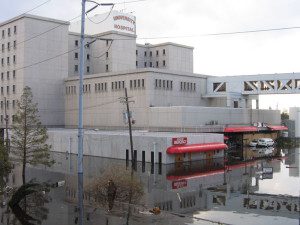Few would question that the triple + one all-hazards threats are measurably greater than when the Homeland Security Presidential Directive 21 was released by the White House in 2007 (Public Health and Medical Preparedness). Evolving Infectious Diseases, More Frequent and Robust Natural Disasters and Geopolitical inspired Terrorists Attacks + one; Increased Violence in Healthcare Delivery Locations – women care givers are the most assaulted group in the nation’s workforce.
 The non-federal healthcare sector with its public/private blend faces the usual set of regulatory requirements. In a free pluralistic healthcare industry, governance is a fragmented and very complex undertaking. Preparing the nation’s healthcare delivery system to cope nature’s threats is formidable, and then adding the possible permutations of creative terrorist threats and newly emerging infectious diseases becomes mind-numbing.
The non-federal healthcare sector with its public/private blend faces the usual set of regulatory requirements. In a free pluralistic healthcare industry, governance is a fragmented and very complex undertaking. Preparing the nation’s healthcare delivery system to cope nature’s threats is formidable, and then adding the possible permutations of creative terrorist threats and newly emerging infectious diseases becomes mind-numbing.
Hospital Boards are legally responsible for all aspects of the health care entity’s activities and services. Among the Board’s liabilities is “Preparedness for disaster/terrorist threatsâ€. While Federal healthcare entities are mandated by Congress to prepare for all-hazards, the non-federal sector relies to all-hazards readiness on a voluntary basis. The overarching theme imbedded in the National  Response Framework (NRF), is the concept of good-faith partnership between and among the nation’s economic sectors; federal, public, private, tribal, and non-governmental. The planning goal is to build a seamless bulwark against natural and man-made threats. Meeting this goal places a heavy dependence on the private sector, which owns or controls up to ninety (90 %) of the nation’s healthcare response capacity.
We have been concerned about the level of awareness to this legal exposure within the health care leadership community. Following hurricane Sandy the press was filled with bizarre statements from NYC health leadership which indicated that placing the most vulnerable patients at great risk without loss of life amounted to successful preparedness. Educating the Board on all-hazards threats is the responsibility of the C-Suite (Administration). Â There is a propensity to only bring good news to the board many times at the expense of physical/facility safety and security. The irony in the failure to articulate the $1 to $7 return on investment for mitigating known vulnerabilities is unfortunate.
 Healthcare trade magazines are reluctant to surface the all-hazards issues, or at least an objective  view of the real situation. Case in point is a publication which targets Hospitals Boards/Trustees.  I renewed my subscription after a hiatus of 10 years and read a recent article “After the storm†by a frequent contributor which was heartwarming and factual, albeit a view through rose-colored glasses.
Healthcare trade magazines are reluctant to surface the all-hazards issues, or at least an objective  view of the real situation. Case in point is a publication which targets Hospitals Boards/Trustees.  I renewed my subscription after a hiatus of 10 years and read a recent article “After the storm†by a frequent contributor which was heartwarming and factual, albeit a view through rose-colored glasses.
Our concern is that it represented only half of the story, discussing the relative success of one New Orleans hospital, while the full story shows that hundreds of lives were needlessly lost. As we enter a new hurricane season, the message to Trustees is that the hospital and healthcare industry has a dismal history of protecting the trusting public. The final count of Katrina-related deaths in NOLA was 971 with 334 of those bodies recovered from hospitals and nursing homes. City officials and healthcare leadership were fully aware that the risks were there from a regional study funded by the federal government. Lessons from Houston Texas’s disastrous flooding from Tropical Storm Allison were not learned or ignored.
 Joplin’s emergency planners had a self- reported comprehensive plan to meet the most likely natural disaster in the area, however they neglected to include some of the most vulnerable populations into the protective umbrella; Long Term Care Facilities. Â Emergency responses organizations could not communicate with each other and advanced warning system for Tornadoes (in Tornado Alley during Tornado Season) failed to make timely warnings. Hospitals in NYC failed to learn lessons from Houston and NOLA; another meter of flooding and there would have been a repeat of NOLA/Katrina, one of the most disastrous and avoidable losses of life in the nation’s healthcare history.
Joplin’s emergency planners had a self- reported comprehensive plan to meet the most likely natural disaster in the area, however they neglected to include some of the most vulnerable populations into the protective umbrella; Long Term Care Facilities. Â Emergency responses organizations could not communicate with each other and advanced warning system for Tornadoes (in Tornado Alley during Tornado Season) failed to make timely warnings. Hospitals in NYC failed to learn lessons from Houston and NOLA; another meter of flooding and there would have been a repeat of NOLA/Katrina, one of the most disastrous and avoidable losses of life in the nation’s healthcare history.
There is a place for warm and fuzzy articles that make the public feel better about readiness, but there is also a responsibility to share the truth that without proper planning and execution there will be (and has been) substantial loss of life, and it unfortunately includes the most vulnerable in the system; newborns, elderly and patients with the most acute illness.
Unfortunately, the Trustees ultimately bear legal responsibility for safe operation of the hospital, yet do not seem to be fully aware of the risks; whether through commission or omission. The current oversight mechanism requires that they be  fully aware of these risks while recent history leads us to believe there is a substantial communication gap.






0 Comments